According to the Hamburg account
 We recently released ABBYY FlexiCapture for Invoices, a solution for streaming the entry of European accounts into EDMS (electronic document management system). Strictly speaking, the “big” ABBYY FlexiCapture can also process bills , on the basis of which a new solution is made. But in it you need to independently set all the settings for working with accounts, and many of our customers, as it turned out, prefer already configured solutions. Well, you understand - get the program out of the box, install Mary on the computer (the product is currently sold only in Europe), connect it to the EDMS - and let it work.
We recently released ABBYY FlexiCapture for Invoices, a solution for streaming the entry of European accounts into EDMS (electronic document management system). Strictly speaking, the “big” ABBYY FlexiCapture can also process bills , on the basis of which a new solution is made. But in it you need to independently set all the settings for working with accounts, and many of our customers, as it turned out, prefer already configured solutions. Well, you understand - get the program out of the box, install Mary on the computer (the product is currently sold only in Europe), connect it to the EDMS - and let it work.The solution is designed specifically for processing only one type of documents - invoices. This allowed us to improve and “sharpen” the technology specifically for these documents (although it allows us to process other documents).
Most importantly, ABBYY FlexiCapture for Invoices has a universal flexible description with which you can correctly extract information from accounts that come from different countries. The program “understands” which country the account is from and “knows” what standards regarding billing exist in that country. This makes it possible to correctly determine where in the invoice, for example, the name of the supplier company, and where the total amount of the invoice is indicated.
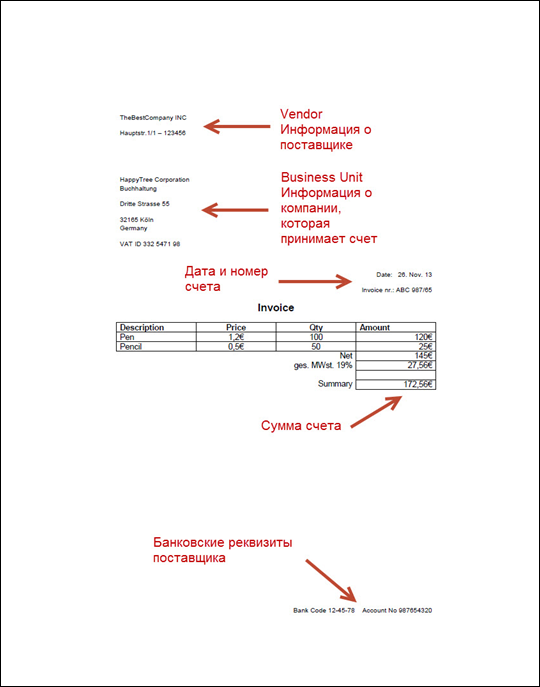
The solution is based on advanced technologies of “flexible descriptions”, created on a large selection of accounts from various suppliers. In other words, we took a lot of accounts from different countries and trained the program not only to distinguish them and correctly determine where and what is indicated in them, but also to decide whether it is possible to accept the received document.
About how flexible descriptions work, we wrote in detail here, therefore, let us say briefly: a flexible description is a formalized description of the structure of a poorly structured document, which is created using the FlexiLayout Studio tool. Unlike hard templates, where the structure of all documents of this type is the same, for poorly structured documents, the location of the fields can differ quite significantly. A flexible description is looking for such fields based on the keywords of the headings, on other fields already found, and so on.
Each country has its own particularities of billing: tax and legal rules, data formats, location of fields and much more. For example, in Switzerland, when calculating taxes on accounts, their value is rounded to 0.05, often downward. This is due to the fact that the smallest coin in Switzerland is 5 centimes (Santim - 0.01 from the Swiss franc). And, for example, in Spain, the name of the same company can be spelled in six different ways, and all these are standard abbreviations.
Such differences, on the one hand, somewhat complicate the task of creating a universal flexible description, and on the other hand help. And they help with the search for the remaining fields of the account. But before you search and recognize fields, you must first determine the recognition language. And for this, you first need to determine the country from which the bill came. This helps the database that the user connected. The database contains a list of suppliers and the necessary information about them: name, address, bank details and, most importantly, country. Having determined the country, the program looks at what settings are inherent in the accounts of this country (taxes, designations, reductions, etc.), after which the remaining fields are searched. In this way, a flexible description is applied and the necessary data is extracted.
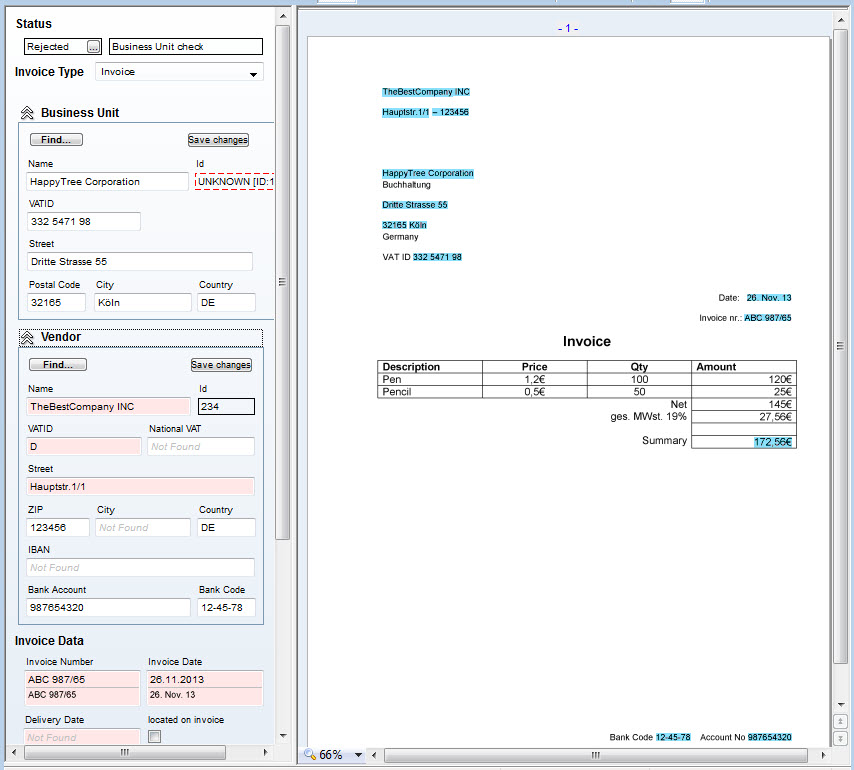
Although the solution is ready for use, the user can improve it and modify it to fit your goals, documents and business processes. FlexiCapture for Invoices uses training technology that allows both the program administrator and the document verification operator (operator Mary - remember?) To adjust the flexible description.
In order to modify the universal flexible description, taking into account the peculiarities of the documents of a particular supplier, the operator should not have any special knowledge and skills. The flexible description is being finalized during the processing of documents: if the operator noticed that a field was not found on the document, or was detected incorrectly, he changes the frame around the field with the mouse, presses the Train button. Pressing the Train button gives the program a signal that, for a given provider, this field is located in a certain place of the account, and the program remembers this, taking into account factors such as the contents of the field, its immediate environment, the geometric relationships of this field and other objects in the image, and others . Further, the flexible description is changed to take into account new properties, and a new version of the flexible description is formed specifically for this supplier.
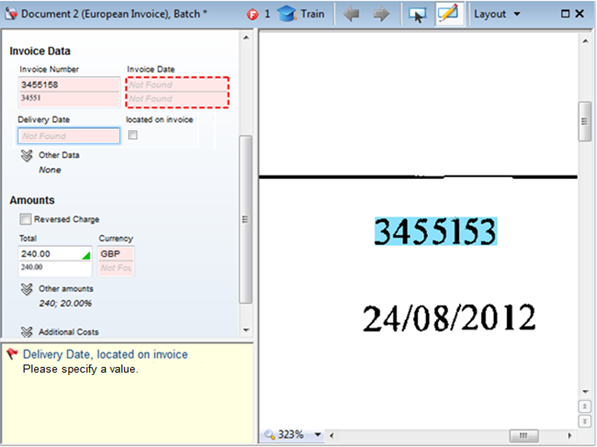
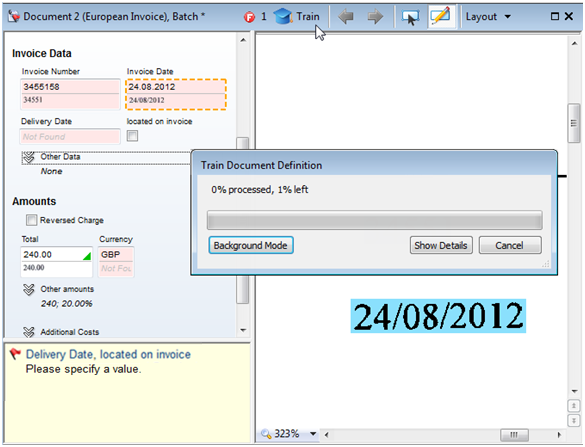
The result of the training (the way it looks inside the program) is a flexible description consisting of several options (branches), each of which describes its subtype of the document from a particular provider. In the learning process, the program “connects” the new properties obtained in the learning process with a specific subtype of the document. The result of superimposing a general flexible description is compared with the result of the trained option, and the best result is selected for each individual field.
The program administrator has several more options for finalizing the template than Mary. He has access to the entire list of flexible description options, and he can also train each of these options. The name of each option is the name of the supplier company. “Inside” each - a selection of documents on the basis of which the training took place.

If the administrator has decided that the documents from a particular provider are processed by the program well enough, he can disable the possibility for operators to learn documents from this provider so Mary does not accidentally spoil the learning results.
In addition to automatic training, the program has a lot of opportunities for customization to the needs of a particular company. The program administrator can see a list of all countries for which a flexible description has been configured. Each country has its own list of settings: a set of languages, legal and tax rules, a set and arrangement of fields. All these settings and properties can be edited (after all, tax laws sometimes change, even in Europe :)), as well as add new countries that are not in the standard list, specify their own settings for them.
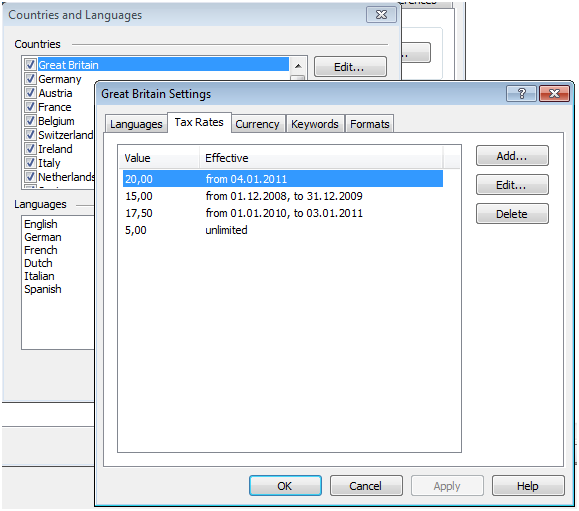
A recognized and verified document can be exported with one of three flags (statuses): Valid - documents that have successfully passed all checks, Exception - documents requiring verification (verification), and Rejected - documents in which, after checking, there are critical errors with which the document cannot be accepted Documents with different statuses can be exported with different settings. The program sets the status automatically as a result of checks, and the operator can change the status of the document, while he needs to write a comment for each document - the reason for the status change.

If such an arrangement of affairs does not suit the administrator, for example, from the point of view of the company's business processes, he may prohibit the operator from changing the value of the Status field.
Here is such a product. We hope that our European users will enjoy ABBYY FlexiCapture for Invoices.
Anastasia Evstratova
Corporate Projects Department
